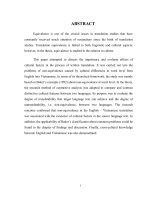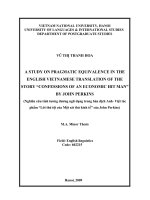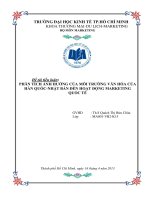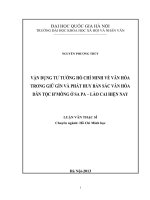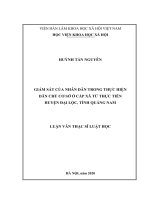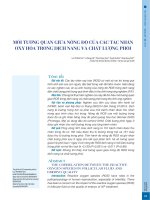HIỆN TƯỢNG KHÔNG TƯƠNG ĐƯƠNG ở cấp độ từ DO NHỮNG KHÁC BIỆT về văn hóa TRONG BIÊN DỊCH ANH VIỆT
Bạn đang xem bản rút gọn của tài liệu. Xem và tải ngay bản đầy đủ của tài liệu tại đây (288.63 KB, 60 trang )
ABSTRACT
Equivalence is one of the crucial issues in translation studies that have
constantly received much attention of researchers since the birth of translation
studies. Translation equivalence is linked to both linguistic and cultural aspects;
however, in the thesis, equivalence is studied in the relation to culture.
This paper attempted to discuss the importance and evaluate effects of
cultural factors in the process of written translation. It was carried out into the
problems of non-equivalence caused by cultural differences at word level from
English into Vietnamese. In terms of its theoretical framework, the study was mainly
based on Baker’s concepts (1992) about non-equivalence at word level. In the thesis,
the research method of contrastive analysis was adopted to compare and contrast
distinctive cultural features between two languages. Its purpose was to evaluate the
degree of translatability that target language text can achieve and the degree of
untranslatability, i.e. non-equivalence, between two languages. The research
outcome confirmed that non-equivalence in the English – Vietnamese translation
was associated with the existence of cultural factors in the source language text. In
addition, the applicability of Baker’s classification about common problems could be
found in the chapter of findings and discussion. Finally, cross-cultural knowledge
between English and Vietnamese was also demonstrated.
i
TABLE OF CONTENTS
ACCEPTANCE i
ACKNOWLEDGEMENTS…………………………………………………………… ii
ABSTRACT……………………………………………………………………………… iii
TABLE OF CONTENTS……………………………………………………………… iv
LIST OF FIGURES…………………………………………………………………… vii
LIST OF TABLES…………………………………………………………………… viii
LIST OF ABBREVIATIONS………………………………………………………… ix
CHAPTER I: INTRODUCTION 1
1.1. Rationale of the Study…………………………………………………………… 1
1.2. Aims of the Study and Research Questions……………………………………… 2
1.3. Scope of the Study………………………………………………………………… 3
1.4. Significance of the Study……………………………………………………………. 3
1.5. Organization of the Study…………………………………………………………… 4
CHAPTER 2: LITERATURE REVIEW 6
2.1. Translation………………………………………………………………………… 6
2.2. Culture………………………………………………………………………………. 7
2.2.1. Definition of Culture…………………………………………………………. 7
2.2.2. Cultural Categories………………………………………………………… 8
2.3. Translation and Culture…………………………………………………………… 10
2.4. The concepts of equivalence from different views of theorists…………………… 11
2.4.1. Jakobson’s concept of equivalence (1959)……………………………… 11
2.4.2. Nida and Taber’s formal and dynamic equivalences (1965)…………………. 12
2.4.3. Catford (1965) and the introduction of translation shifts…………………… 12
2.4.4. Baker’s view on translation equivalence (1992)……………………………… 13
2.5. Non-equivalence at word level proposed by Baker (1992)…………………………. 14
2.6. Strategies to overcome non-equivalence………………………………………….…. 18
CHAPTER 3: RESEARCH METHODOLOGY 20
3.1. Subjects of the study………………………………………………………………… 20
3.2. Data collection methods and procedures……………………………………………. 21
3.3. Data analysis methods and procedures……………………………………………… 22
CHAPTER 4: FINDINGS AND DISCUSSION 23
4.1. Untranslatability caused by culture – specific concepts…………………………… 23
4.1.1. Ecology……………………………………………………………………… 24
ii
4.1.2. Material culture…………………………………………………………… 26
4.1.3. Social culture………………………………………………………………… 28
4.1.4. Organizations, Customs, Ideas and Habits…………………….…………… 29
4.2. Problems relating to the source language……………………………………………. 34
4.2.1. Lack of lexical sets ………………………………………………………… 34
4.2.2. Different expressive meanings………………………………………………. 36
4.2.3. Specific forms in English……………………………………………………. 37
4.3. Problems relating to the target language…………………………………………… 38
4.3.1. Lack of superordinates (general words)…………………………………… 38
4.3.2. Lack of hyponyms (specific words) ………………………………………… 39
4.2.3. Differences in physical or interpersonal perspectives………………………. 41
4.4. Discussion of findings……………………………………………………………… 41
CHAPTER 5: SUGGESTIONS AND CONCLUSION……………………………… 45
5.1. Suggestions to overcome the problems………………………………………………. 45
5.1.1. Translation by cultural substitution…………………………………………. 45
5.1.2. Translating by explanation after a loan word……………………………… 46
5.1.3. Translating by a paraphrase………………………………………………… 47
5.1.4. Translating by omission………………………………………………… 47
5.1. Summary of findings………………………………………………………………… 48
5.2. Limitations of the study…………………………………………………………… 49
5.3. Suggestions for further studies……………………………………………………… 50
REFERENCES 51
iii
LIST OF FIGURES
Figure Page
Figure 1 Different equivalents for “bamboo” 26
Figure 2 Possible translations of the pronoun “he” 34
iv
LIST OF TABLES
Table Page
Table 1 Translations of the word “rice” into Vietnamese 25
Table 2 Different meanings of rice in certain contexts 25
Table 3 Related English words have the same equivalent. 26
Table 4 Translation of several culture-specific terms by cultural
borrowings
28
Table 5 Translation of words relating to religion 29
Table 6 Vietnamese kinship terms 30
Table 7 Possible translations of the term “aunt” into Vietnamese 31
Table 8 First class of pronouns in Vietnamese 33
Table 9 Comparison the use of plural and singular forms between
SL and TL
38
Table 10 English equivalents for the word “đàn” in Vietnamese 40
Table 11 Example of cultural substitution from English to 45
v
Vietnamese
Table 12 Example of further explanation added in the TL 46
Table 13 Example of using paraphrasing in TL 47
Table 14 Example of omission in translation 49
LIST OF ABBREVIATIONS
SL: Source Language
TL: Target Language
ST: Source Text
TT: Target Text
CSCs: Culture-Specific Concepts
OALD: Oxford Advanced Leaner’s Dictionary
EVLD: English Vietnamese Lac Viet Dictionary
vi
vii
CHAPTER 1: INTRODUCTION
1.1. Rationale of the Study
In the era of globalization, translation has become an important aspect for the
development of the world culture and society since the need to exchange thoughts and
opinions among different nations has been ever increasing. It is considered a bridge
among unfamiliar languages, indigenous cultures and experiences. As stated by
Newmark (1988) “translation has been instrumental in transmitting culture” (p. 7),
which means translation is the solution to challenges of cultural barriers among
countries.
In Western translation theory, translation equivalence is a principal concept. The
theory of equivalence has been interpreted and approached in separate ways by
translation theorists. In his work on translation equivalence, Catford (1965) stresses the
importance of equivalence in translation by stating that the nature of translation is “a
replacement of a textual material in the source language (SL) by equivalent textual
material in the target language (TL)” and adds that “central problem of translation
practice is that of finding translation equivalents” (p. 21). Approaching with a similar
point, Leonardi (2000) also confirms that the notion of equivalence was undoubtedly
one of the most problematic and controversial areas in the field of translation theory. In
addition, Nida and Taber (1969) highlight the importance of equivalence in translation
theory. They argue “translation consists in reproducing in the receptor language the
closest natural equivalent of the SL message, first in meaning and secondly in terms of
style” (p. 12). In brief, equivalence is crucial to translation because it is closely linked
to the process of transferring information in translation.
In general, the role of equivalence in the translation theories has drawn much
attention of scholars, researchers and translators since the birth of translation studies in
the late twentieth century. Despite examining the issue in a relatively different view,
1
this thesis, entitled “Non-Equivalence Relating to Cultural Differences at Word
Level in English-Vietnamese Translation” was still dedicated to the subject of
translation equivalence on a smaller scale. It also aimed at raising the knowledge for
translators when encountering English and Vietnamese documents and their awareness
to the linguistic and cultural elements of the ST.
1.2. Aims of the Study and Research questions
This thesis was a methodical investigation into the subject of non-equivalence
problems caused by cultural differences affecting the process of translating from
English to Vietnamese. The first aim of the research was to show the relationship
between cultural differences and the occurrence of non-equivalence in English-
Vietnamese translation. Secondly, based on Baker’s general theories (1992) in the field
of translation, the thesis analyzed and evaluated the applicability of her theories to the
case of English-Vietnamese translation. More specifically, the study investigated the
problems relating to cultural distinctions between Western countries and Vietnam, one
representative of Eastern countries. The study also provided answers to the two
research questions:
(1) What is the relationship between cultural differences and non-equivalence in
the case of English-Vietnamese translation?
(2) How could Baker’s theory about non-equivalence at word level (1992) be
applied to the case of English-Vietnamese translation?
Likewise, the study proposed possible strategies and general guidelines for
achieving equivalence at word level in the two languages. Last but not least, the study
was expected to raise readers’ attention to the matter of culture in translation. It should
be noted that translation is a conscious process of linguistics learning as well as
cultural knowledge revising. In other words, translation is not about conveying single
meanings based on word-for-word or sentence-for-sentence but rendering messages
2
from one language into another indeed. However, a lot of inexperienced translators
may not properly appreciate the importance of the issue. Therefore it is hoped that the
study would give a modest contribution to the further strivings in translation practice
among translators.
1.3. Scope of the Study
This paper examined the phenomena of non-equivalence involved in cultural
differences in translation when translators convey information or ideas from English to
Vietnamese. It showed the ways the cultural variations have been transferred by
translators between two languages. Moreover, this research dealt with translation
problems from English into Vietnamese only at the level of word instead of at various
levels since word is the basic unit of meaning in linguistics. The study mainly took an
approach to typical words with high frequency of occurrence in two cultures when
each of them stands separately or depends on a certain context. An analysis was carried
out into some specific sentences or paragraphs translated into Vietnamese at word
level. The study of their Vietnamese translations contributed to the clarification of the
findings of the cultural contrastive analysis of English and Vietnamese.
1.4. Significance of the Study
Language and culture are always in a state of flux over time. As a result of their
constant change and evolution, no complete theories are general and universal enough
to cover every issue in the realm of language and culture. Similarly, a great variety of
research activities by scholars such as Peter Newmark, Susan Bassnett, Lawrence
Venuti, etc. in translation studies demonstrate the most popular matters which can be
found in many languages. Nevertheless, to some extents, the disadvantage is that those
theories may not correctly and fully reflect existing problems in a specific language.
Therefore, the study could be regarded as a bridge between internationally recognized
translation theories and their relevance and applicability to the case of English-
3
Vietnamese translation. It is believed that this study is one of the studies emphasizing
the problems relating to cultural difference in the process of transferring ideas from
English into Vietnamese. Accordingly, the writer of this research focused on cultural
aspects as the most crucial factors that cause non-equivalence issues at word level.
Further it also pinpointed the applicability of suggested procedures to deal with
the phenomena of non-equivalence at word level in English-Vietnamese translation. In
addition, this research provided students majoring in translation with prominent
cultural knowledge and useful techniques to overcome difficulties when they encounter
English texts. Not limited in written translation, it could be among some useful sources
to those who wish to become interpreters in the future as well. The findings could
make them more aware of problematic areas in translation and culture. In addition,
teachers, other students and also experts who are interested in linguistics and culture of
Western countries and Vietnam may find part of this research useful.
1.5. Organization of the Study
The thesis includes the following five chapters.
Chapter 1 (Introduction) describes an overview of the study including five sub-
sections: Rationale of the Study, Aims of the Study and Research questions, Scope of
the Study, Significance of the Study and Organization of the Study.
Chapter 2 (Literature Review) discusses critically relevant information and
establish a theoretical framework for the subject area.
Chapter 3 (Methodology) explicates the subjects of the study, data collection
methods and procedures and data analysis methods and procedures.
Chapter 4 (Findings and discussion) presents, analyzes and explains the results
that were achieved from collected data.
4
Chapter 5 (Suggestions and Conclusion) provides suggestions to overcome the
problems, a summary of findings, limitations as well as some suggestions for further
research.
5
CHAPTER 2: LITERATURE REVIEW
In this chapter, outstanding theories and ideas involved in the research problem
are presented systematically to support the content and analysis of the paper. This
chapter describes the definition of translation and culture, relationship between
translation and culture, the concepts of equivalence from different views of theorists,
common problems of non-equivalence at word level proposed by Baker (1992) and
strategies to deal with non-equivalence proposed by Baker (1992).
2.1. Translation
Depending on each researcher’s interest and expertise in the field, translation
has been defined and stressed on specific elements. Newmark (1988, p. 5) defines
translation as “renderring the meaning of a text into another language in the way that
the author intended the text”. With this definition, he puts an emphasis on the essence
of translation that is to convey meaning between two languages. On the other hand,
Wilss (1982) highlights the term “equivalent” and translation requirements in his
definition: “Translation is a transfer process, which aims at the transformation of a
written SL text into an optimally equivalent TL text, and which requires the syntactic,
the semantic and the pragmatic understanding and analytical processing of the SL.” (p.
3)
In a larger scope, Bell (1991) clarifies the notion of “translation” in three
distinguishable meanings: 1) Translating (the process); 2) A translation (the product of
the process of translating) and 3) The translation (the abstract concept which
encompasses both the process of translating and the product of that process) (p. 13).
A more comprehensive definition is suggested by Bassnett (1980). She
emphasizes on the accuracy of transferred meaning in comparison with the original
meaning and similarity between two structures after translation:
6
Nida and Taber (1969) also similarly approach the issue like Bassnett (1980)
when stating the two requirements of a translation process: “Translating consists in
reproducing in the receptor language the closest natural equivalent of the SL message,
first in terms of meaning and secondly in terms of style” (p. 21).
From all the above definitions, in spite of differences in each researcher’s word
choice and expression, a general idea about the definition of “translation” can be
found. In short, the term “translation” refers to the process of conveying the meaning
of one language to another language as clearly as possible without changing the
meaning of the ST.
The translation process involves in transferring both written and spoken SL
texts to equivalents in TL texts but due to a time limit, the thesis covered only written
one.
2.2. Culture
2.2.1. Definition
As a very broad category, it is undoubtedly hard to propose a comprehensive
definition for the term “culture”. In 1984, Larson defines culture as “a complex of
beliefs, attitudes, values, and rules which a group of people share” (p. 431). He notes
that the translator needs to understand beliefs, attitudes, values, and the rules of the SL
audience in order to adequately understand the ST and adequately translate it for
people who have a different set of beliefs, attitudes, values, and rules. More
specifically concerned with language and translation, Newmark (1988, p. 94) affirms
“culture as the way of life and its manifestations that are peculiar to a community that
7
translation involves the rendering of a source language (SL) text into the target
language (TL) so as to ensure that (1) the surface meaning of the two will be
approximately similar and (2) the structure of the SL will be preserved as closely as
possible, but not so closely that the TL structure will be seriously distorted. (p. 12)
uses a peculiar language as its means of expression.” Foley (1997) contributes a
general overview about definition of culture: “A culture is a mental system which
generates all and only the proper cultural behavior” (p. 108). Moreover, Kluckhohn
(1951) presents a more concrete definition which shows numerous signified aspects of
culture:
(cited in Culture’s Consequences:
Comparing Values, Behaviors, Institutions, and Organizations across Nations (2nd
ed), Hofstede 2000, p. 9)
Throughout history, culture has been defined in a spread of ways since every
community or society shapes its own unique culture and has distinctive methods to
foster the culture. From the above concepts, it can be shortly concluded that culture
refers to physical objects that can be touched, seen, etc. and spiritual realms such as
language, arts, beliefs and customs, religions and rituals that are passed down through
generations.
2.2.2. Cultural categories
Newmark (1988) describes his five “cultural categories” that cultural words
belong to:
(1) Ecology
As a whole, according to Newmark (1988), the category of ecology
encompasses: flora, fauna, winds, plains, hills (p. 96). He also points out “geographical
8
Anthropologically, culture consists in patterned ways of thinking, feeling and reacting,
acquired and transmitted mainly by symbols, constituting the distinctive achievements
of human groups, including their embodiments in artifacts; the essential core of culture
consists of traditional (i.e. historically derived and selected) ideas and especially their
attached values (p. 86).
features can be normally distinguished from other cultural terms in that they are
usually value-free, politically and commercially” (p. 96).
(2) Material Culture
Material culture involves: food, clothes, houses and towns and transport in
which food is the most sensitive and important expression of national culture for many
countries because food has the widest variety in translation procedures (Newmark,
1988, p. 97).
(3) Social Culture
Vocabulary related to work and leisure such as cricket, bull-fighting, squash,
etc. can be defined as part of social culture. Newmark (1988) also mentions that “in
considering social culture one has to distinguish between denotative and connotation
problems of translation” (p. 98). Connotative meaning in each country is different; a
word may have a positive connotative meaning in one culture but not in another.
(4) Organizations, Customs, Activities, Procedures, Concepts
Newmark (1988) defines three sub-divisions of the fourth classification
including political and administrative, religious and artistic concepts (p. 99).
(5) Gestures and Habits
Gestures and customary of each and every country are long built up with
uniqueness. Newmark (1988) comments that “there is a distinction between description
and function which can be made where necessary in ambiguous cases” (p. 102) since a
gesture or a habit may occur in one culture but not in others, or maybe there are
differences in meaning among cultures.
9
In the next chapter, the study utilized the cultural typology suggested by
Newmark (1988) to categorize cultural elements taken from STs in English.
2.3. Translation and Culture
Translation is no longer just a process of conveying meaning words for words
but has developed as an instrument of language analysis. Owing to “language is largely
culture oriented” (Ray, 2008, p. 48), cultural factors are obviously seen in the ST in
addition to linguistic ones. Komissarov (1991), from a similar standpoint, states that
“the cultural factor in translation is also undeniable if not so obvious”. Understanding
the hindrances caused by cultural barriers, Ray (2008) concludes that “culture and
culture-words create a good deal of problems in translation” and “….culture-words…
are difficult to translate for there is no one to one correspondence between one culture
and another or one language to another” (p. 48). In brief, culture is unquestionably a
source of difficulties for translators. Accordingly, cultural knowledge problems should
be taken into serious consideration due to their important impacts on translation
performance. In other words, intercultural awareness should be among translators’
priorities in the process of translating because translating means we are encountering
with an alien culture containing “long historical background and various cultural
connotations” (Cui, 2012). A wide variety of cultural differences such as dialects,
proverbs, idiomatic expressions and so forth can be found in such an alien language
setting. Apart from their linguistic expertise, they need to build up a thorough
understanding of the culture of the SL as well as that of the TL. As a result, cultural
sensitivity is one of the important factors translators need to consider.
Cultural and social background is significantly important to people who practice
translating as their profession. It is English that “contains more words than any other
language on the planet” and “more than 14 words are added to English every day”
(Sutter, 2009). Due to English’s complex and constant expansion, a translator needs to
10
stay informed and enhance his awareness of cultural knowledge to convey the message
appropriately to the TL.
To sum up, “culture includes and affects language, it is this ground from which
language grows and develops” (Komissarov, 1991). All languages are the product of
the culture as well as of the nation. They all have long historical backgrounds and
various cultural connotations. Each society will interpret a message in terms of its own
culture. The meaning of a word in a language is derived from its culture and represents
the main connection between language and culture.
2.4. The notion of equivalence from different views of theorists.
2.4.1. Jakobson’s concept of equivalence (1959)
Roman Jakobson introduces the notion of “equivalence in difference” in his paper
“On linguistic aspects of translation”, which paves the way for the theoretical analysis
of translation (1959, p. 232). He suggests three kinds of translations:
(1) Intralingual translation is an interpretation of verbal signs by means of other
signs of the same language.
(2) Interlingual translation is an interpretation of verbal signs by means of some
other language.
(3) Intersemiotic translation is an interpretation of verbal signs by means of signs of
non-verbal sign system.
These types of translation bring translation studies closer to direct translation
equivalence as the cornerstone, the starting and finishing point of the translation
activity. Jakobson (1959) states clearly that “Equivalence in difference is the cardinal
problem of language and the pivotal concern of linguistics. Like any receiver of verbal
messages, the linguist acts as their interpreter” (p. 224). He acknowledges in the case
11
of interlingual translation, the aim of a translator is to transfer codes in different
languages but still to keep the same message and purpose that the ST wants to transmit
at first.
2.4.2. Nida and Taber’s formal and dynamic equivalences (1965)
Another influential concept of translational equivalence is Nida and Taber’s
dichotomy of formal equivalence and dynamic equivalence in 1965:
(1) Formal correspondence consists of a TL item which represents the closest
equivalent of a SL word or phrase. Nida and Taber clarify that there are not always
formal equivalents between language pairs because it creates problems in translating
cultural expressions.
(2) A dynamic equivalence is to reproduce “in the receptor language the closest
natural equivalence of the source-language message…” The essence of dynamic
equivalence is the receptor’s response. However, it could provoke misunderstanding to
the target audience.
2.4.3. Catford (1965) and the introduction of translation shifts
Catford’s approach to translation equivalence (1965) is more linguistic-based
and this approach is based on the linguistic work of Firth (1957) and Halliday (1961).
He defines translation in terms of equivalence: “Translation may be defined as follows:
The replacement of textual material in SL by equivalent textual material in another TL
(1965). Catford proposes very broad types of translation in terms of three criteria:
(1) The extent of translation (full translation vs. partial translation);
(2) The grammatical rank at which the translation equivalence is established
(rank-bound translation vs. unbounded translation);
12
(3) The levels of language involved in translation (total translation vs. restricted
translation).
The role of translation, therefore, is to introduce one culture to another by
means of translating. However, translatability is a substantial issue. Catford (1965)
points out the problems of untranslatability divided into: linguistic and cultural
untranslatability. According to Catford (1965, p. 94), linguistic untranslatability is due
to lack of formally corresponding feature in the TL, meanwhile untranslatability arises
when “a situation feature, functionally relevant for the SL text, is completely absent in
the culture of which the TL is a part” (p. 99). However, in later part, he “invalidates his
own categories of cultural untranslatability” (Bassnett 1980, p. 41) and considers that
“this would be a type of linguistic untranslatability” (Catford 1965, p. 101).
2.4.4. Baker’s view on translation equivalence (1992)
One outstanding feature of Baker’s studies is that new adjectives have been
assigned to the notion of equivalence such as grammatical and textual equivalence.
Baker (1992) makes a more specific list of concepts where equivalence is explained.
She explores the notion of equivalence at different levels, in relation to the translation
process, including all different aspects of translation and hence putting together the
linguistic and the communicative approach. She distinguishes between:
(1) Equivalence that can appear at word level and above word level, when
translating from one language into another.
(2) Grammatical equivalence, when referring to the diversity of grammatical
categories across languages.
(3) Textual equivalence, when referring to the equivalence between a SL text
and a TL text in terms of information and cohesion.
13
(4) Pragmatic equivalence, when referring to implicatures and strategies of
avoidance during the translation process
2.5. Non-equivalence at word level proposed by Baker (1992)
When a translator reads a text, he tries to communicate the overall meaning of
the text. To achieve this aim, he needs first to understand the meaning of the smaller
units that carry the meaning in the text. Words and their meanings that are among
factors affecting non-equivalence in translation have been researched for a long time.
Baker (1992) affirms that, in a bottom-up approach to translation, equivalence at word
level is the first element to be taken into consideration by the translator (p. 18). In fact,
when the translator starts analyzing the ST he looks at the words as single units in
order to find a direct “equivalent” term in the TL.
An extremely interesting discussion of the notion of equivalence can be found in
Baker (1992) who offers a more detailed list of conditions upon which the concept of
equivalence can be defined. She develops a clear classification of non-equivalences at
word level in translation which has received a lot of support from researchers.
(a) Culture-specific concepts (CSCs)
Baker (1992) refers to such cultural words and concedes that the SL words may
express a concept which is totally unknown in the target culture. The concept in
question may be abstract or concrete; it may relate to a religious belief, a social
custom, or even a type of food. She points out that the concept in question may be
“abstract or concrete, it may relate to a religious belief, a social custom, or even a type
of food.” Such concepts are called “culture-specific items” (Baker, 1992, p. 21).
(b) The source-language concept is not lexicalized in the TL
14
The source-language word may express a concept which is known in the target
culture but simply not lexicalized, that is not “allocated” a target-language word to
express it.
(c) The source-language word is semantically complex
According to Baker (1992, p. 22), it refers to the circumstance that “a single
word which consists of a single morpheme can sometimes express a more complex set
of meanings than a whole sentence”. The problem emphasizes the non-existence of
one-to-one relationship between SL words and TL words. Words in SL can be
paraphrased or explained into long sentences rather than equivalents in TL.
(d) The source and TLs make different distinctions in meaning
In this case, the TL makes more or fewer distinctions in meaning than the SL
(Baker, 1992, p. 22). It is the cultural identity of each country that regulates when and
how to use the words to refer to a similarly recognized phenomenon in real world.
(e) The TL lacks a superordinate
Superordinate is a general word covering similar or the same sematic meanings
that can be found in some words. A superordinate acts as an “umbrella” covering
general sematic meanings of related words. (Baker, 1992, p. 22)
For example, the super-ordinate meaning of the English word “meal” has a sub-
division (hyponym) of several kinds of feed such as “breakfast”, “lunch”, “dinner”, and
“supper”.
(f) The TL lacks a specific term (hyponym)
15
Languages tend to have general words (superordinates) but lack specific ones
(hyponyms) (Baker, 1992, p. 23), since each language makes only those distinctions in
meaning which seem relevant to its particular environment.
(g) Differences in physical or interpersonal perspective
Physical perspective may be of more importance in one language than it is in
another. Perspective may also include the relationship between participants in the
discourse.
(h) Differences in expressive meaning
TL may have a different expressive meaning that may be considerable or subtle,
but important enough in encountering translation problems. The translator can
sometimes add the evaluative element by means of a modifier or adverb if necessary,
or building it in somewhere else in the text.
(i) Differences in form
There is often no equivalent in the TL for a particular form in the ST. Certain
suffixes and prefixes which convey propositional and other types of meaning in
English often have no direct equivalents in other languages.
(j) Differences in frequency and purpose using specific forms
There may be a difference in the frequency or purpose that is used when a
particular form has a ready equivalent in the TL. For example, “English uses the
continuous –ing form for binding clauses much more frequently than other languages
which have equivalents for it” (Baker, 1992, p. 25).
(k) The use of loan words in the ST
16
Loan words are used when even the source language has no appropriate words
to name or denote new concepts and situations. The problem causes translators
confused as they may not know the exact meaning and/or additional meaning of the
word used. In this case, a translator has to work with the third language, which can
bring about the loss in translation because of the increasing mismatch among
languages.
Leonardi (2000) investigates the equivalence in translation between myth and
reality. She mentions that Baker (1992) discovers the notion of equivalence at word
level in translation procedures. When translating from one language to another, the
equivalence at word level is the first element to be taken into consideration by
translators. They should remember and pay attention to a single word that could be
assigned different meanings in different languages. The different meanings in the SL
and the TL may cause remarkable changes in the way that the message is carried
across. Particularly, in her study, non-equivalence at word level of Baker (1992) is
thoroughly introduced and analyzed as a way to confirm the validity and dependability
of the theory.
Trinh (2002) is also a supporter for Baker’s theories (1992). His article about
equivalence and strategies to deal with the problems in interpreting is based on the
analysis of most common problems as in Baker’s taxonomy (1992) about types of non-
equivalence. In the fourth part about – “Đi tìm cái tương đương” (How to achieve
equivalence) one of the central parts of his article, he adopts four out of eleven
problems in Baker’s taxonomy (1992) to analyze the cases of English-Vietnamese
translation and vice versa. This part is a combination of detailed explanations for the
notable professor’s and his own sharp arguments and evidence. However, the four
problems are not limited at the level of word but Trinh also opens the scope to the level
of phrase. Consequently, it can be seen that Trinh (2002) appreciates and highly value
Baker’s scheme.
17
In summary, Baker (1992) is one of many translation professors who
extensively explored the non-equivalence at word level. Her categories of non-
equivalence at word level and strategies to address the problem have been employed by
many scholars to study and solve the non-equivalence at word level. With the hope to
examine translation theories in a specific language, the study applied Baker’s
taxonomy of non-equivalence at word level and strategies as an instrument of analysis
in English-Vietnamese translation.
2.6. Strategies to overcome non-equivalence at word level
Baker’s translation strategies for non-equivalence at word level (1992) are listed
as follows:
(1) Translation by a more general word
This strategy is about using a more general word to translate a word in the
source language with no specific equivalent in the target language.
(2) Translation by a more / less expressive word
The strategy uses more neutral /less word to replace words which don’t have
equivalent words. TL near-equivalents which are close to both propositional and
expressive meaning of the original word are used to translate the ST.
(3) Translation by cultural substitution
This strategy refers to the replacement of a culture-specific items or expression
with a TL item which does not have the same propositional meaning but can make a
similar impact in the target text.
(4) Translation by using a loan word or loan word plus explanation
18

